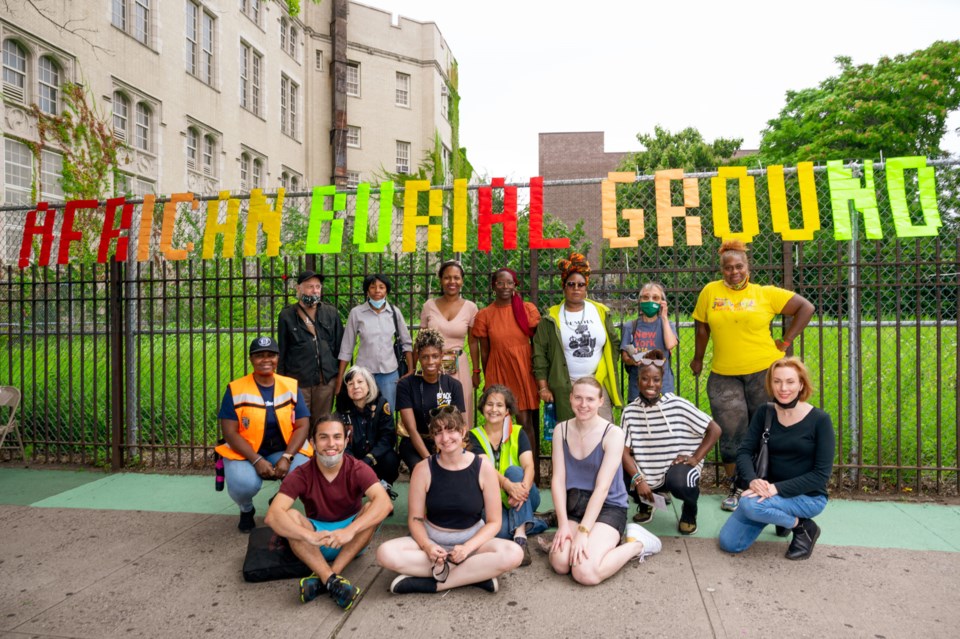A slave named Eve, owned by the wealthy slaveowner Lawrence Voorhes, died in Flatbush and was laid to rest there at a cemetery for people of African descent.
"Her remains were piously interred in the African burying ground of the village of Flatbush, attended by a great concourse of the people of colour," an 1810 Long Island Star obituary said, according to the New York City Cemetary Project.
Today, the site at the corner of Bedford and Church Avenues is vacant. Public School 90, which was built in the 19th century at that location, was demolished in 2015.
"I feel a powerful presence when I'm there," Shantell Jones, a local resident, told BK Reader. "I usually stand there and try to have a moment of silence"
Eve's obituary said that she loved flowers and gardening. That's why Jones and other members of the Flatbush African Burial Ground Coalition named the site Eve's Garden.
Jones, the civic and community engagement coordinator for the organization, envisioned a memorial plaque with the names of the enslaved people who were buried there mounted on a brick wall, along with lots of flowers and plants in the space.
"I see it as a pilgrimage site, just like the African Burial Ground in lower Manhattan," the coalition's lead organizer Shanna Sabio told BK Reader.
"Brooklyn deserves its own monument."
Are city officials listening?
Coalition members face an uphill battle to bring their visions to fruition.
In October 2020, Mayor Bill de Blasio announced plans to build a residential high-rise on the site that he said would include 130 affordable housing units.
Sabio said the coalition met on August 25 with City Councilmember Mathieu Eugene, whose district includes the burial ground.
In the meeting, the members explained their position and told Eugene they want a stop to the construction bidding process, as well as robust community engagement. They offered input and expertise from coalition members who are professionals in fields like architecture and urban planning.
"We're not anti-affordable housing, we just don't want affordable housing on top of a burial ground," she recalled explaining to Eugene, who leads the city's task force involved in community engagement.
BK Reader contacted Eugene's office for comments but did not receive an immediate response.
When the City announced the construction project, Eugene expressed support for the complex, which was expected to include educational and vocational training facilities.
"This wonderful project will have a positive impact in the lives of so many people, including our youth who are in dire need of opportunities where they can acquire the tools for success," Eugene stated.
Who's buried there?
According to a statement from the mayor's office, "a small number of fragments of human remains, which may be associated with a historical burial ground for people of African ancestry" were found at the site. Those remains were taken to the minister of the Reformed Dutch Church of Flatbush for reinterment in their consecrated cemetery.
An excavation in the early 2000s recovered human teeth and fragments of a mandible, but no graves at the site, according to the NYC Cemetary Project.
But the coalition questioned if the search was thorough. They want a ground-penetrating radar survey to find out if human remains are still there.
"We feel very strongly that there are still ancestors there," Jones said. "Even if it were to come out that there are no more bones there, we still feel as though this site shouldn't be touched."
"It's a historically significant site where there once were remains of African people," Sabio added.
Furthermore, there's no evidence that the remains were transferred to the church, Jones said. The members want to find the bones and reinter them at the burial site.
"It makes no sense to us that they took the bones of enslaved people and returned them to their enslavers at the Dutch Reformed Church," Sabio said.
Building grassroots support
Residents have responded positively to the coalition's organizing efforts. Many of them are outraged that the history "has been kept from them," Jones said. So far, they've collected more than 1,800 petition signatures.
Their efforts have included walking tours of the historic site and teach-ins.
One of the upcoming events is a Zoom education program on Sept. 24 with archeologist Dr. Michael Blakey, who directed the African Burial Ground Project in Manhattan. The program starts at 4:00pm; for more information, click here.



.png;w=120;h=80;mode=crop)
